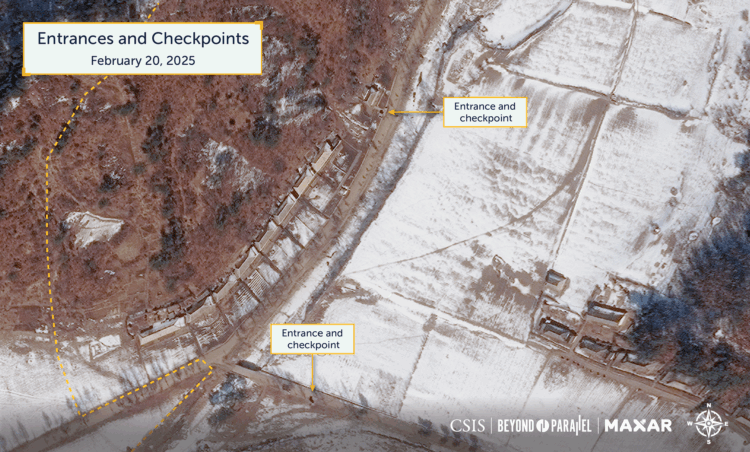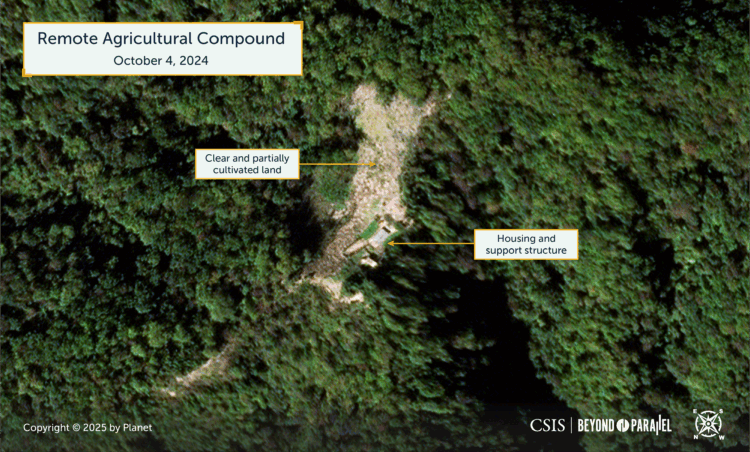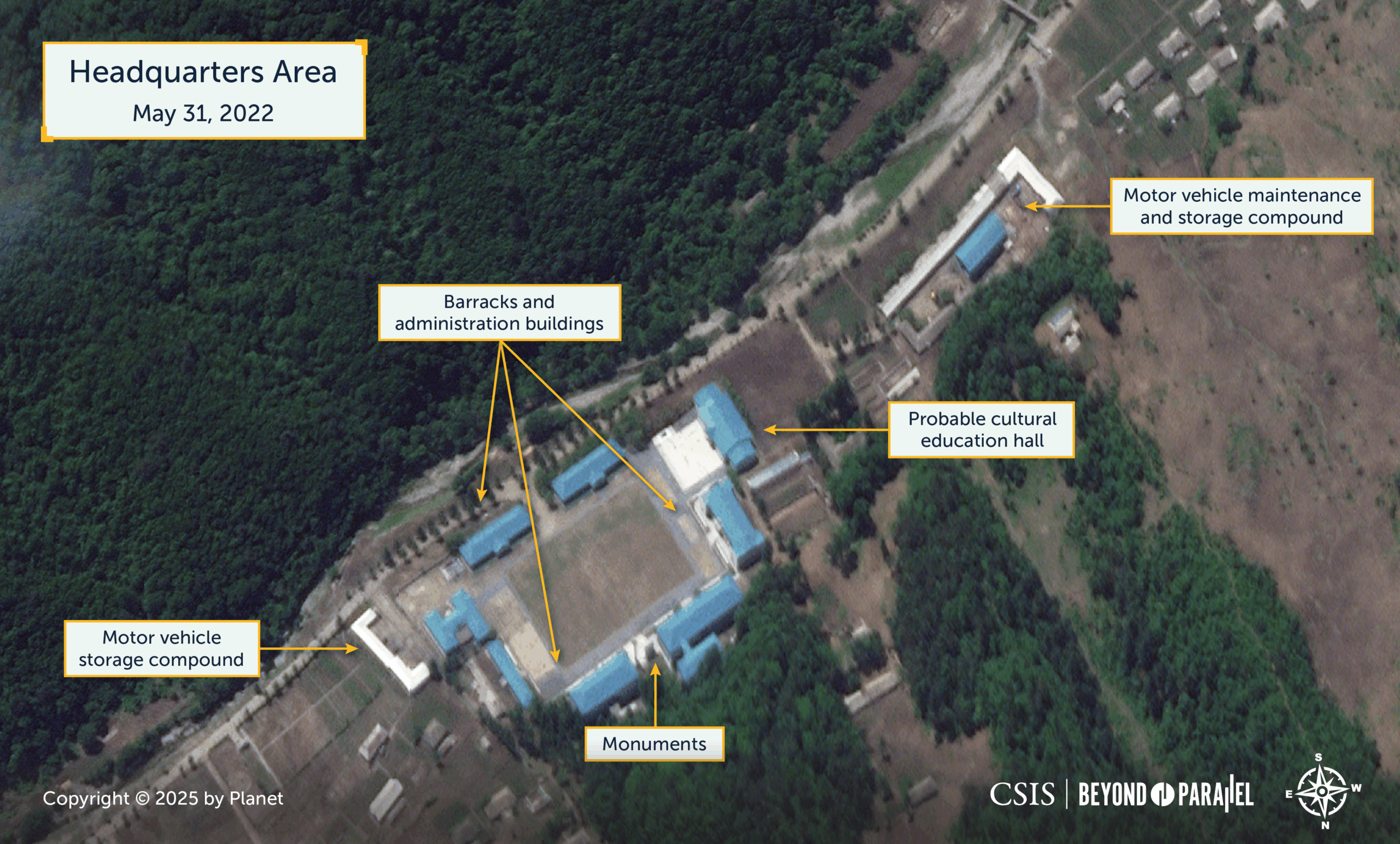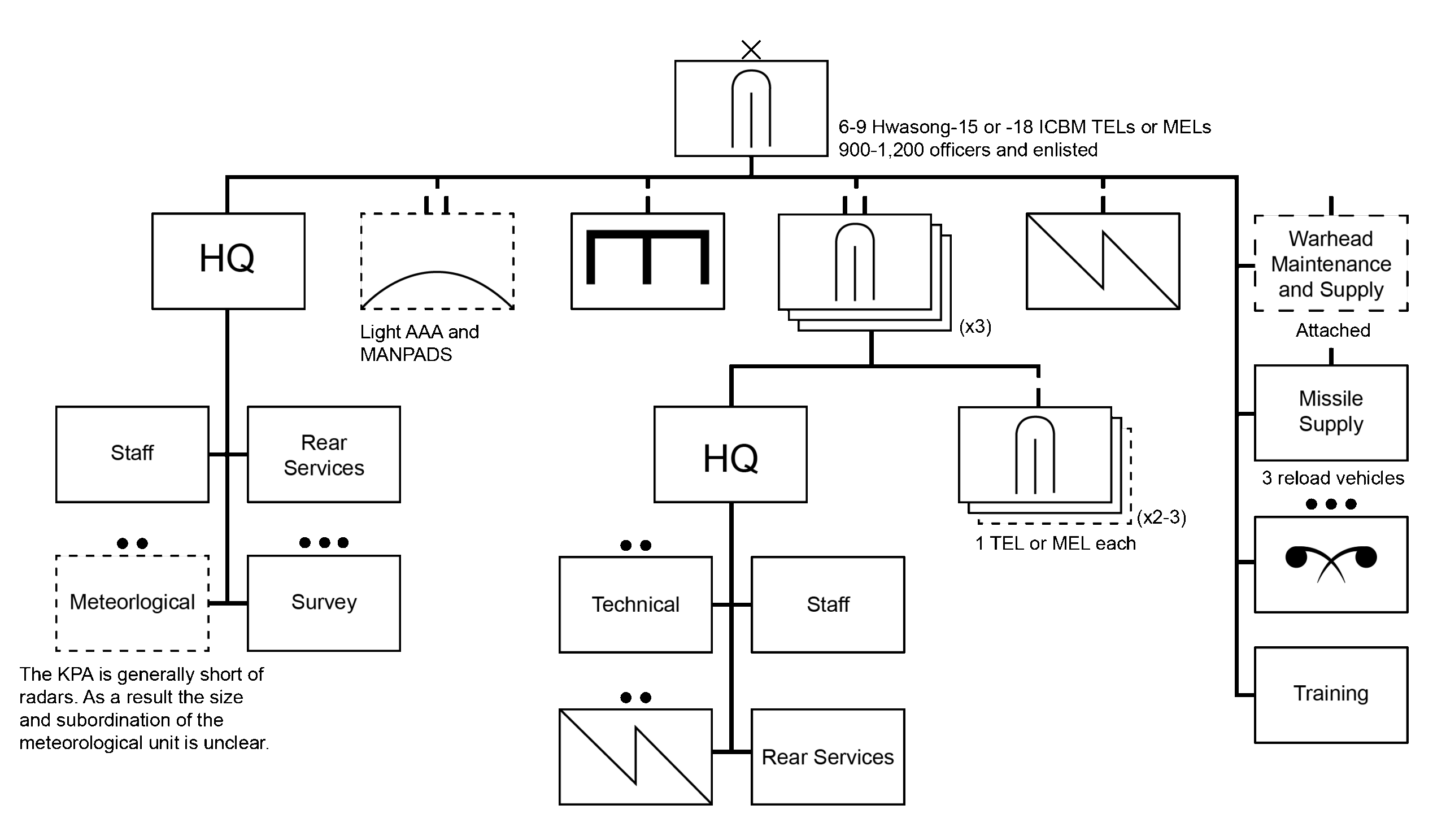
Undeclared North Korea: Sinpung-dong Missile Operating Base
As featured in the Wall Street Journal “North Korea Has a Secret Long-Range Missile Base Near Chinese Border, Report Says” on August 20, 2025.

Key Findings
- Located approximately 27 kilometers from the China-North Korean border, the Sinpung-dong Missile Operating Base is an undeclared ballistic missile operating base in North Pyongan Province. The base is one of North Korea’s approximately 15-20 ballistic missile bases, maintenance, support, missile storage, and warhead storage facilities which North Korea has never declared. This is the first in-depth open-source study confirming the base.
- Preliminary analysis suggests that the base likely houses a brigade-sized unit equipped with a total of 6-9 nuclear capable Hwasong-15 or -18 intercontinental ballistic missiles (ICBM), or an as yet unknown ICBM, and their transporter-erector-launchers (TEL) or mobile-erector-launchers (MEL). These missiles pose a potential nuclear threat to East Asia and the continental United States.
- Current assessments are that during times of crisis or war, these launchers and missiles will exit the base, meet special warhead storage/transportation units, and conduct launch operations from dispersed pre-surveyed sites.
- The Sinpung-dong Missile Operating Base and the other missile bases within North Korea’s strategic ballistic missile belt (including other undeclared bases like the Hoejung-ni, Sangnam-ni and Yongnim Missile Operating Bases) represent the primary components of what is presumed to be North Korea’s evolving ballistic missile strategy, and its expanding strategic-level nuclear deterrence and strike capabilities.
- The Sinpung-dong Missile Operating Base is not known to have been the subject of any denuclearization negotiations previously conducted between the United States and North Korea.
Overview
The Sinpung-dong (신풍동) Ballistic Missile Operating Base is located (40.316252 125.276505) in Taegwan-gun (대관군, Taegwan County), Pyongan-bukto (평안북도, North Pyongan Province), approximately 12 kilometers northeast of the city of Taegwan.
The base is 27 kilometers from the border with China, approximately 146 kilometers north-northwest of Pyongyang, and 340 kilometers northwest of Seoul. All satellite imagery from 2003 onwards indicates that the base is active and being well-maintained by North Korean standards. Significantly, this imagery also shows that the base has continued to be developed.

Sinpung-dong is part of North Korea’s strategic (or rear) missile belt, along with the missile operating bases at Hoejung-ni, Sangnam-ni, Yongjo-ri, and Yongnim. This missile belt is one component of a widely-dispersed nationwide hardened ballistic missile network subordinate to the approximately 10,000-person strong Strategic Force Strategic Force—the Korean People’s Army (KPA) organization responsible for all North Korea’s 15-20 undeclared ballistic missile bases, maintenance, support, missile storage, and warhead storage facilities.
The Sinpung-dong base and the other missile bases within the strategic ballistic missile belt represent the primary components of what is presumed to be North Korea’s evolving ballistic missile strategy, and its expanding strategic-level nuclear deterrence and strike capabilities. Taken together, the ballistic missiles deployed within the strategic belt pose a potential nuclear threat to East Asia and the continental United States.
Construction of the base began sometime around 2004 and was generally complete and operational by 2014. As with the other missile operating bases within the strategic ballistic missile belt, it is believed to have been built using specialized engineering troops from the KPA’s Military Construction Bureau.1 This ten-year construction timeline, when taken in context with the construction of the other strategic ballistic missile belt’s missile bases, suggests a considerable level of North Korean developmental planning that is rarely appreciated outside the Korean Peninsula. There is an even chance that ongoing improvements since 2014 are related to a combination of ongoing IRBM and ICBM developments, basing requirements, and organizational developments.
North Korea is not known to have made any specific public references to the existence of the Sinpung-dong base or the KPA unit based here. Additionally, neither of their national designators is known.2 As such, the provisional title of Sinpung-dong Missile Operating Base is derived from its location adjacent to the village of Sinpung-dong. Media reports over the years referring to a missile base at Changsong-gun, Paegun-dong, Paegun-tong, Paekun-dong, Sakju-gun (the county adjacent to Taegwan-gub), Sakju-up, Taegwan-gun, or Taegwan-up are most likely referring to the Sinpung-dong base.3
Although the details concerning the precise model of ballistic missile deployed at the Sinpung-dong base have not been confirmed, it is believed that the unit based here is equipped with nuclear capable Hwasong-15, -18, or an as yet unknown intercontinental ballistic missiles (ICBM), their transporter-erector-launchers (TEL) or mobile-erector-launchers (MEL), and various support vehicles at the base. During times of crisis or war, these launchers and missiles will exit the base, meet special warhead storage/transportation units, and conduct launch operations from dispersed pre-surveyed sites. 4 If the two unique large earth-bermed support structures identified within the base serve as emergency launch sites, then warhead storage and maintenance units of necessity would deliver warheads to the launchers at the base before returning to their own base.
Base Organization
The Sinpung-dong (신풍동) Ballistic Missile Operating Base is located (40.316252 125.276505) in Taegwan-gun (대관군, Taegwan County), Pyongan-bukto (평안북도, North Pyongan Province), approximately 12 kilometers northeast of the city of Taegwan.
It is situated within an isolated narrow mountain valley that runs generally southwest to northeast on the southern slopes of Pugo-san (부거산, Pugo Mountain) and is bisected by a stream. The entire base is estimated to encompass approximately 22 square kilometers. As of July 2025, the base can be functionally divided into six general activities:
- entrance checkpoints
- headquarters and administration (including barracks, civilian housing, and vehicle maintenance)
- warehouses areas
- hardened drive-through missile checkout facilities (sometimes referred to as missile support facilities)
- large underground facility
- a variety of dispersed small housing and support buildings
The overall layout and design of the Sinpung-dong Missile Operating Base is comparable to that of the Yongnim Missile Operating Base, as it is also dispersed within an isolated narrow wooded mountain valley with branch valleys. The main valley, beginning at the agricultural village of Sinpung-dong (신풍동), extends approximately 4.8 kilometers from southwest to northeast and features a stream that meanders along its center. To support movement across the stream throughout the base, three 5 to 7-meter-wide reinforced concrete deck bridges and a 6-meter-wide ford were built between 2018 and 2021. Four smaller valleys branch eastward from the main valley.
Satellite images from 1984 and 1995 show that the valley in which the base will later be built consisted of small agricultural and logging activities (often transitory), dispersed along the length of the main valley and on the adjacent slopes. As can be presently determined, construction of the base began sometime around 2005 and 2006, with two checkpoints positioned at the foot of the main valley at Sinpung-dong.5

Entrance Checkpoints and Remote Compounds
The entrances and checkpoints of the missile base are located in the southwest corner of the perimeter. Along with the entrances and checkpoints, the base is surrounded by at least seven remote compounds with small, cultivated fields. The positioning of these compounds suggests that they are likely to serve some security role. Aside from these compounds, numerous small and often transitory agricultural and forestry activities have been observed over the years at the upper ends and on the lower slopes of each of the valleys.


Click to enlarge. Left: Checkpoints at entrance to the Sinpung-dong missile operating base, February 20, 2025. Copyright © 2025 by Maxar. Right: One of the small remote agricultural or logging compounds located around and above the perimeter of the base that likely also serve some security purpose, October 4, 2024. Copyright © 2025 by Planet. Image may not be republished without permission. Please contact imagery@csis.org.
The Sinpung-dong Missile Operating Base is situated within a valley and the four smaller valleys that branch from the main valley. To ease readability in this report, the smaller branch valleys of the base are simply identified as branch #1 to #4, running from southwest to northeast.
The first entrance checkpoint leads approximately 4.8 kilometers northeast up the main valley. The second checkpoint leads approximately 1.7 kilometers east up branch valley #1. Moving up the main valley, the first checkpoint leads through housing for senior officers and dependents, a warehouse area, motor vehicle maintenance and storage facilities, agricultural support areas (including large greenhouses), the entrance to branch valley #2, and on to the headquarters and administration area at Wonha-ri. Approximately 86 senior officer housing structures were built between 2014 and 2017 as additions to the original 16 agricultural housing structures. The original motor vehicle maintenance and warehouse facility was built between 2006 and 2011 across several existing small agricultural warehouses.
Headquarters and Administration Area
Located approximately 1.7 kilometers up the primary valley is the headquarters and administration area (40.316236 125.276576). This area is similar in size and layout to those found at other missile operating bases. Construction began around 2004 and was completed by 2007. This area primarily consists of eight large buildings, including a cultural education hall (added between 2018 and 2019), headquarters, barracks, a second, but smaller, motor vehicle storage facility, and two formal circular gardens.6 The buildings are arranged around a central parade ground or football pitch and a small memorial plaza. Since 2019, only minor modifications have been observed here, including the expansion of the motor vehicle maintenance and storage facility, the construction of a second smaller motor vehicle storage facility, and the construction of several small buildings.

Hardened Drive-Through Missile Checkout Facilities
Proceeding northeast from the headquarters area, there are additional barracks compounds, agricultural support areas, and the entrance to branch valley #3. Moving further northeast, there are at least two additional barracks areas, agricultural support areas, and the entrance to branch valley #4. Located at this entrance are the base’s two hardened drive-through missile checkout facilities (40.327571 125.297224 and 30.328032 125.298187) that were built on the east side of the valley between 2011 and 2014. These are used for missile arming, fueling, systems checkout, and maintenance operations.
Each checkout facility consists of a large, concrete-reinforced shelter cut into the side of the adjacent mountain, measuring approximately 35 meters by 17 meters, and is covered with soil and rocks, with vegetation planted on top. The length and size of the openings are of sufficient size to accommodate all known and likely planned KPA ballistic missile transporter-erector-launchers (TELs), mobile-erector-launchers (MELs), transporter-erectors (TEs), and missile support vehicles and equipment. As at other ballistic missile operating bases, North Korea has planted trees and bushes over the entrances to these hardened facilities to conceal them. The maturing vegetation makes it increasingly challenging to locate them using commercial satellite imagery except in winter months, when vegetation is sparse.


Right: The base’s two completed hardened drive-through missile checkout facilities, October 4, 2024. Copyright © 2025 by Planet. Vegetation has covered the facilities making them difficult to locate and identify. Image may not be republished without permission. Please contact imagery@csis.org.
Underground Facility (UGF)
The main valley continues northeast from the hardened drive-through missile checkout facilities and entrance to branch valley #4. The two entrances to the base’s UGF are located here: one at the northern end of the main valley (40.330859 125.299040) and the other within branch valley #4 (40.328936 125.300770).
The construction of the UGF entrances at the Sinpung-dong base is unique compared to that of other ballistic missile operating bases. To accommodate both the steep terrain and mountain streams that seasonally flood, the two UGF entrances were built approximately 20 to 40 meters above the streams. This necessitated the use of terraced construction, featuring large ramps—likely utilizing much of the rock and gravel tailings excavated from the UGF—leading up to the entrances, with water tunnels beneath them to allow the stream to flow.
The openings for both entrances are approximately 5.5 meters wide, and, like the hardened drive-through facilities, can accommodate all known and likely planned launchers, missile support vehicles, and equipment. Unlike UGF entrances at other North Korean missile operating bases, there are no large rocks and soil protective berms to help protect them from attack.
No significant changes have been observed in satellite imagery from 2014 to the present at either of the UGF entrances. However, similar to the base’s two hardened drive-through facilities, the growth of vegetation around the entrances has made it increasingly challenging to locate them using commercial satellite imagery.
The UGF itself was built between 2006 and 2014, and the straight-line distance between the two entrances is approximately 258 meters. However, given what is known concerning large North Korean UGF construction, it is likely that the UGF is considerably longer and contains several side galleries. Although additional small underground facilities or bunkers at the Sinpung-dong base are also likely, none have been reliably confirmed to date.


Right: A more recent overview of the entrances to the base’s completed underground facility, October 4, 2024. Copyright © 2025 by Planet. Vegetation has covered the entrances, making them difficult to locate and identify. Image may not be republished without permission. Please contact imagery@csis.org.


Right: A more recent view of the completed northern entrance to the base’s underground facility, October 4, 2024. Copyright © 2025 by Planet. Vegetation has covered the entrance, making it difficult to locate and identify. Image may not be republished without permission. Please contact imagery@csis.org.


Right: A more recent view of the completed southern entrance to the base’s underground facility, October 4, 2024. Copyright © 2025 by Planet. Vegetation has covered the entrance, making it difficult to locate and identify. Image may not be republished without permission. Please contact imagery@csis.org.
Drive-Through Bunkers
Back at the two checkpoints at the foot of the main valley, the second checkpoint leads east to branch valley #1. This approximately 2-kilometer-long valley consists of another small headquarters area, barracks, and support buildings. Notably, the valley also features three narrow bunkers on its south side. These appear to be 40 to 55-meter-long Type 500 bunkers that are typically used to house vehicles of various types.7 Collectively, these elements in the branch valley likely support a battalion-sized armor, mechanized, or motorized unit of unknown type. Because these bunkers and the headquarters area appear in images taken before the construction of the base, the unit housed here may not have originally been intended to be a part of the planned missile base.

Supported Structures
Approximately 600 meters up from the checkpoint at the foot of the main valley is the entrance to branch valley #2, which extends approximately 1.5 kilometers to the east. With one exception, this valley is dedicated to a small number of agricultural support and logging activities. However, the one exception is notable. An approximately 24-meter-by-7-meter open earth-bermed support structure is located approximately 650 meters up the branch valley on its north side (40.308947 125.278393). Constructed sometime between 2013 and 2014, this is one of two such structures located within the Sinpung-dong missile operating base.

Approximately 2.3 kilometers up from the checkpoint at the foot of the main valley and 1.7 kilometers from the entrance to branch valley #2 is the entrance to branch valley #3. This branch valley extends approximately 1.5 kilometers to the east. It contains two barracks areas, several support areas, and the second of two open earth-bermed support structures.
About 575 meters up the branch valley, near the village of Kahyon-dong, there are the remains of a 31-meter-by-9-meter building that was present from about 2014 to 2019 and may have been used for launcher maintenance, repair, or training—satellite images of the Sinpung-dong base do not show any specialized drive-through maintenance and training building with arched clearstory as seen at other locations such as the Kal-gol Ballistic Missile Operating Base.

At about 1.2 kilometers up the branch valley #3 is a 60-meter-long tall multi-roof support building constructed in 2019, replacing a football pitch. Finally, the second of two open earth-bermed support structures within the Sinpung-dong missile operating base is located (40.315029 125.310078) approximately 2.3 kilometers up the branch valley. This structure is on the north side of the valley and measures approximately 27 meters by 7 meters. Constructed sometime between 2013 and 2014, this is one of two such structures (see branch valley #2 above).

The precise purpose of the two open earth-bermed support structures noted above is unknown. They are unique in that they share the same construction design (approximately the size to support a Hwasong-15 or -18 ICBM launcher) and are aligned at approximately 18° north; similar structures have not been identified at other missile operating bases.
When the construction of these support structures was first identified, it was thought that they would be UGF entrances. We now know that this is not the case, as known strategic UGF entrances are constructed differently, and no significant waste is typically produced during the excavation of a UGF. It was then thought that these may have been a North Korean attempt at producing coffin-style launch complexes like those used by some early U.S. Atlas D and E ICBMs during the Cold War or, more recently, at Iranian missile bases near Shiraz and Tehran. If this were the intention, it would suggest North Korea’s desire to develop a rapid reaction launch capability to be used during emergencies rather than facing the risk of large ICBM launchers being destroyed while deploying outside the base. Nevertheless, these structures have remained unchanged since 2014. Ultimately, they may have simply been warehouse structures that were never completed.
Due to the strategic importance of North Korea’s ballistic missile operating bases and concerns of either pre-emptive or wartime air or cruise missile strikes against them, most missile operating bases have some level of organic air defense capabilities. This does not appear to be the case with the Sinpung-dong Missile Operating Base. There are no readily identified fixed anti-aircraft artillery (AAA) positions within 10 km of the base. However, the base is within the national air defense network, and there are four air defense artillery batteries and a SA-2 (S-75 Dvina) surface-to-air missile base within 14 kilometers of the base. Regardless, the subcomponents of the missile unit based at Sinpung-dong undoubtedly possess some organic air defense elements, potentially including an air defense battalion, equipped with both light AAA and shoulder-fired air defense missiles (e.g., SA-7, SA-14, SA-16, etc.). The nearest Korean People’s Air Force airbase is Panghyon Airbase, located 43 kilometers to the southwest, which operates an air regiment of vintage MiG-17/19 fighters and ground-attack aircraft.
Order-of-Battle
There is no reliable information concerning the organization or size of the ballistic missile unit located at the Sinpung-dong Ballistic Missile Operating Base. Preliminary assessment is that the base houses a brigade-sized unit, based on analysis of the high-resolution satellite images since 2003, combined with interview data, open-source information, reported KPA ballistic missile organizations, and other known KPA unit organizational structures. Using this assessment, the unit is likely composed of three missile-firing battalions, with a total of 6-9 Hwasong-15 or -18 ICBM TELs/MELs, along with various support units.8

Research Notes
This report, like others in the series, draws on Joseph S. Bermudez Jr.’s ongoing study of North Korea’s ballistic missile infrastructure, begun in 1985. It is informed by interviews with defectors and officials worldwide, as well as declassified documents and open source information.
Accuracy in any open source discussion of North Korea’s nuclear, biological, chemical, or ballistic missile programs is always a challenge. While some of the information used in the preparation of this study may eventually prove to be incomplete or incorrect, it is hoped that it provides a new and unique look into the subject. This study aims to offer a fresh perspective and update previous work by the authors on these topics.
Although 35 high- and medium-resolution satellite images were analyzed during the preparation of this report, the images ultimately presented in this report were purposely selected for their detailed or historical view of the structures and activities within and around the Sinpung-dong missile operating base.
Gazetteer of Named Places
| Name | Coordinates |
| Changto-ryong (장토령) | 40.345278 125.313333 |
| Kahyol-lyong (가현령) | 40.316667 125.316667 |
| Kahyon-dong (가현동) | 40.316389 125.297778 |
| Pugo-san (부거산) | 40.340278 125.279722 |
| Sinpung-dong (신풍동) | 40.301111 125.268056 |
| Wonha-ri (원하리) | 40.315005 125.274800 |
| Won-ni (원리) | 40.293611 125.253333 |
| Wonpung-dong (원풍동) | 40.30000 125.262500 |
| Yodae-dong (여대동) | 40.317222 125.261111 |
| Yoha-ri (요하리) | 40.321667 125.259722 |
| Taegwan-gun (대관군) | 40.207631 125.204750 |
References
- Interview data acquired by Joseph S. Bermudez Jr. A brief description of the specialized engineering troops of the KPA’s Military Construction Bureau can be found in Bermudez Jr., Joseph S. Shield of the Great Leader: The Armed Forces of North Korea, (London: I.B. Taurus, 2001). ↩
- All KPA units have official and cover designations. The latter is what is commonly seen being used in North Korea media. For example, a fictional unit mentioned in North Korean media might have a cover designation of “KPA Unit 158,” however, its official designation is the “19th Infantry Division.” Some units also have an honorific name assigned to its official designation in recognition of some significant accomplishment. Using the previous example of the “KPA Unit 158” an honorific designation could be the “19th Kusong Guard Infantry Division.” To make this situation more complicated it is not unusual for a cover designation to be randomly changed. Cover designations are sometimes referred to as “military unit cover designation” (MUCD). ↩
- The first reference to the use of the Sinpung-dong Missile Operating Base designation known to the author occurred during the 2010s in the author’s conversations with defense and intelligence officials. It is unclear if a lone, and potentially incorrect, reference to a missile base in Sakchu-gun, P’yŏnganbuk-do is referring to the Sinpung-dong Ballistic Missile Operating Base as Sakchu-gun and Taegwan-gun are adjacent counties. ↩
- Interview data acquired by Joseph S. Bermudez Jr. ↩
- As with many rural agricultural villages in North Korea the size and configuration of Sinpung-dong has undergone changes over the years and only cultivated fields and a few small housing clusters from the original village remain. The area, however, is still identified by this name on contemporary maps. Located immediately outside the base entrance is the small agricultural village of Wonpung-dong. Relatively nearby, but also outside the base, are the small agricultural villages Yoha-ri, Yidae-dong, Won-ni, and Wonpung-dong. These villages and the small agricultural and logging activities within or adjacent to the base undoubtedly provide some level of support to the base. ↩
- The cultural education hall was added between 2018 and 2019 and a second but smaller motor vehicle storage facility was built between 2019 and 2022. ↩
- These bunkers are frequently and erroneously identified as “tank tunnels.” While they sometimes do house tanks, they are known to also house armored personnel carriers, self-propelled artillery, etc. ↩
- The limited available information regarding the organizational structures of KPA ballistic missile units indicates that these units may not correspond directly to Western military organization models. Some reports describe KPA ballistic missile units as being larger than a regiment but smaller than a brigade, or larger than a battalion but smaller than a regiment. Confusing this further, organizational terms such as regiment and brigade are sometimes used interchangeably for the same unit. On occasion, the terms “branch detachment,” “office,” “base,” or “division” have also been used to describe a missile unit’s size. Interview data acquired by Joseph S. Bermudez Jr. ↩
